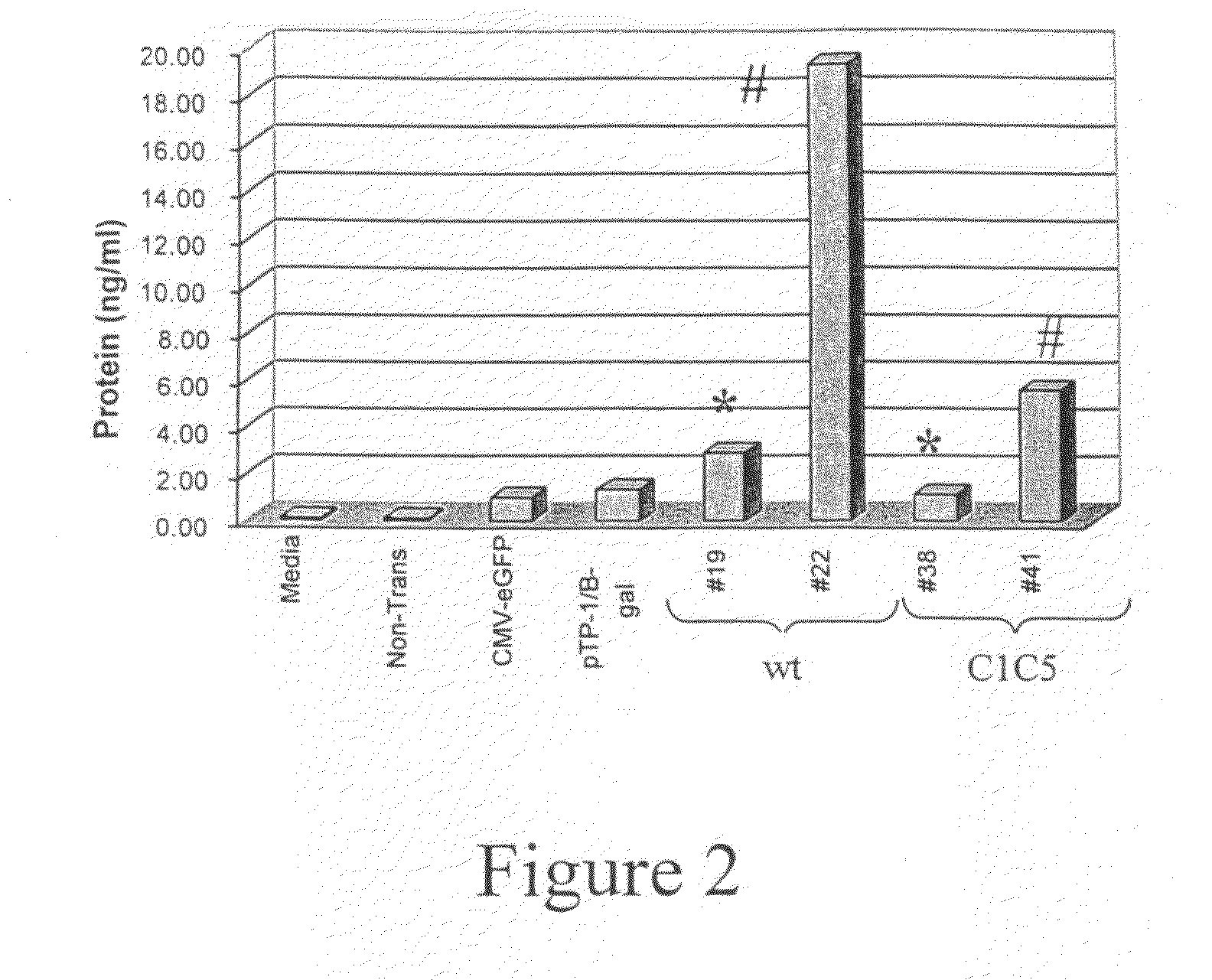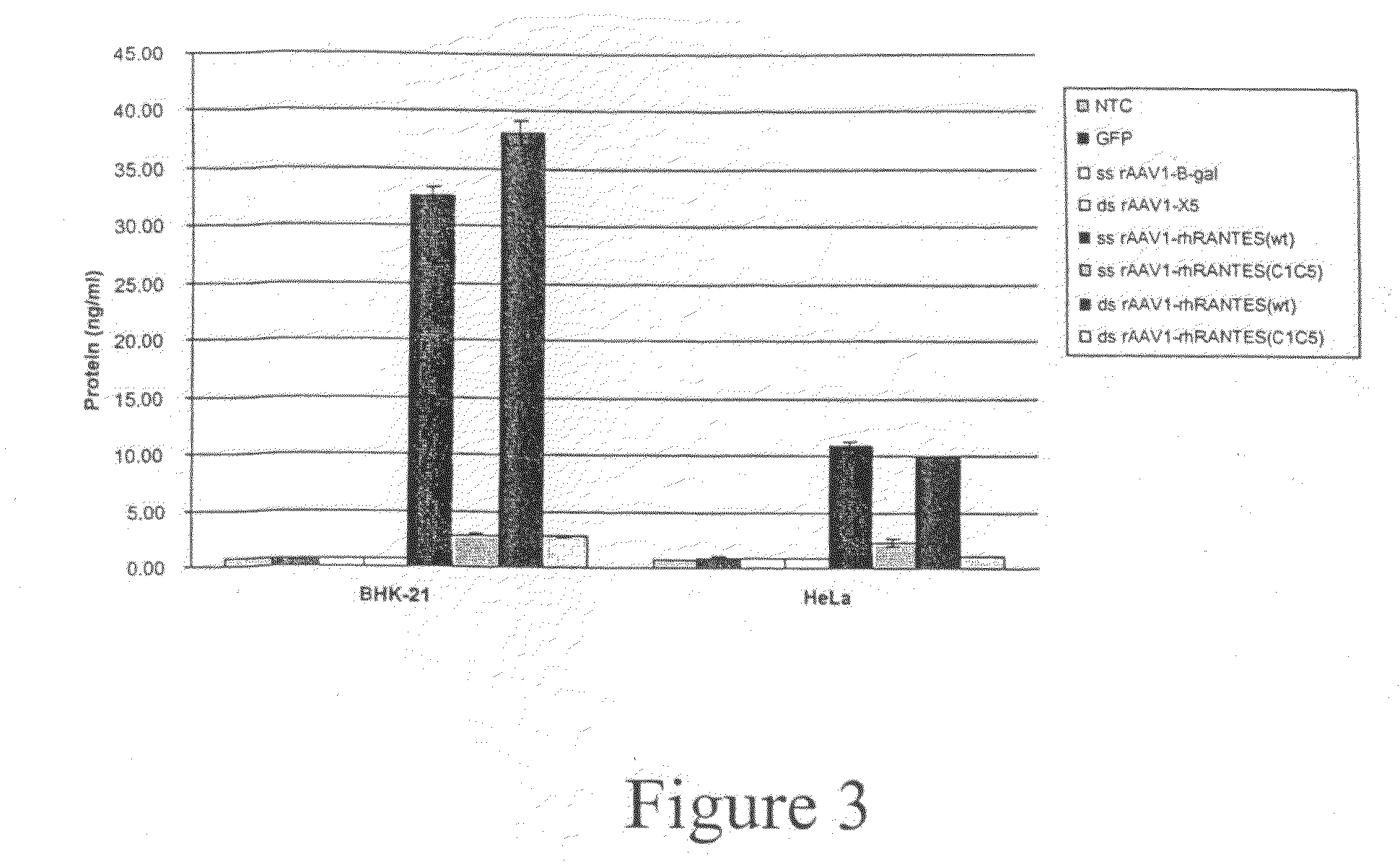Expression of virus entry inhibitors and recombinant AAV therefor
a technology of entry inhibitors and virus, which is applied in the field of recombinant adenoassociated viruses, can solve the problems of slow progression to disease, inability to resist superinfection, and toxic treatment regimens, so as to reduce the incidence or severity of opportunistic infections, improve the effect of cd4-positive t cells and slow progression
- Summary
- Abstract
- Description
- Claims
- Application Information
AI Technical Summary
Benefits of technology
Problems solved by technology
Method used
Image
Examples
example 1
Use of Rantes Chemokine Derivatives to Inhibit HIV-1 Infection Via CCR5 Co-Receptor Blockade
[0046]Since primary HIV-1 isolates almost exclusively utilize CCR5 as the co-receptor for initial infection of cells, the chemokine RANTES (a natural CCR5 ligand) represents an ideal candidate for competitive blockade of the CCR5 co-receptor. The present inventors contemplate that elevated plasma levels of the RANTES chemokine will significantly attenuate or prevent HIV-1 infection of CD4+ cells and that the approach will be well-tolerated in vivo, since individuals who are deficient in CCR5 signaling are healthy and lack obvious immunological defects.
[0047]As described below, rhesus RANTES genes (wild-type and a non-signaling mutant) have been cloned into rAAV-1 vectors and are delivered into mouse muscle tissue. In order to maximize circulating rhRANTES expression levels as well as decease its proinflammatory activities, optimized molecular constructs were generated. First, an optimized lea...
example 2
Delivery and Expression of Genes Encoding HIV-1 Fusion Inhibitor Peptides T-20 and T-1249 to Inhibit HIV-1 Replication and Growth
[0063]A second attractive target for HIV-1 entry inhibition is the final step of the HIV-1 infection process, fusion of the viral envelope with the cell membrane. Fusion is mediated by the gp41 envelope glycoprotein and a model of gp41-mediated membrane fusion analogous to the “spring-loaded” mechanism of influenza virus has been proposed. The sequence of gp41 contains two heptad-repeat regions termed HR1 and HR2 that denote the presence of hydrophobic regions found in 2 alpha-helical “coiled-coil” structures. Significantly, mutations in these HR regions interfere with the fusion property of gp41. The model predicts that the gp120-gp41 trimer holds each gp41 moiety in a high-energy configuration, with the fusion peptide pointed inward, toward the viral surface. The binding of gp120 to CD4 and chemokine co-receptors appears to release gp41 from this configu...
PUM
| Property | Measurement | Unit |
|---|---|---|
| composition | aaaaa | aaaaa |
| length | aaaaa | aaaaa |
| lifetime | aaaaa | aaaaa |
Abstract
Description
Claims
Application Information
 Login to View More
Login to View More - R&D
- Intellectual Property
- Life Sciences
- Materials
- Tech Scout
- Unparalleled Data Quality
- Higher Quality Content
- 60% Fewer Hallucinations
Browse by: Latest US Patents, China's latest patents, Technical Efficacy Thesaurus, Application Domain, Technology Topic, Popular Technical Reports.
© 2025 PatSnap. All rights reserved.Legal|Privacy policy|Modern Slavery Act Transparency Statement|Sitemap|About US| Contact US: help@patsnap.com



